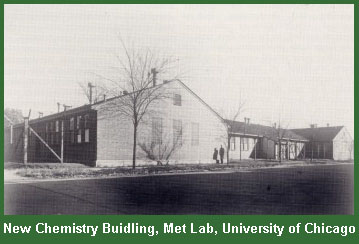
Places
"Met Lab"
(Metallurgical
Laboratory)
MAKING OF THE MET LAB Places > Met Lab (METALLURGICAL LABORATORY)
Places > Met Lab (METALLURGICAL LABORATORY)
On October 9, 1941, Vannevar Bush, director of the newly-created Office of Scientific Research and Development (OSRD), met with President Franklin D. Roosevelt and Vice President Henry A. Wallace to discuss the uranium research program. Bush told them that the British, in their July 1941 MAUD report, had concluded that an atomic bomb was feasible, could produce an enormous explosion, and be ready in approximately two years. Bush warned, however, that it was not a proved case, and he could not state unequivocally that an attempt to build an atomic bomb would be successful. Roosevelt instructed him to expedite the program in every possible way but not to move beyond research and development. Bush's main task was to reorganize the uranium program for a quick decision on building the bomb. On December 13—six days after the Pearl Harbor attack-he put the organizational machinery in place, creating a Planning Board headed by Eger V. Murphree and appointing Harold Urey, Ernest Lawrence, and Arthur Compton as program chiefs. Urey headed up work including diffusion and centrifuge methods and heavy-water studies. Lawrence took electromagnetic responsibilities. Compton was charged with weapon theory and the fission chain reaction for producing plutonium. 
Compton, a Nobel Prize winner and chairman of the Department of Physics at the University of Chicago, did not, like Urey and Lawrence, have a centralized project on his own campus. Research in experimental piles was ongoing at several major universities, primarily the University of Chicago, Princeton, and Columbia. The University of California, Berkeley, was home to significant theoretical and plutonium work. Yet this dispersed research made it difficult for the different research groups to consolidate their results. Compton recognized the value of centralizing research, even as he recognized the impossibility of physically locating all of the research in one place. Compton and Lawrence first concluded that Berkeley was the best choice mainly because it would be impossible to move the giant cyclotron magnets located there. The scientists and administrators on the East Coast, however, rejected the idea of centralizing research at Berkeley, and so Compton decided on January 24, 1942, to start bringing the Princeton and Columbia groups to the University of Chicago. In this arrangement, the primary pile research was done at Chicago, though other experimental and theoretical work could be done at the pre-existing facilities at other universities and laboratories. Compton later noted that in choosing Chicago he went against the recommendations of 75 percent of his advisors because he "felt greater confidence" that he could "see the job through at Chicago better than at any alternative site." In the final days of January 1942, Compton organized the Metallurgical Laboratory (Met Lab), a code name to preserve the secrecy of uranium research. The University of Chicago had attempted since 1936 to establish a metallurgical laboratory, and, as Compton observed, "Our Chicago colleagues saw nothing surprising in a wartime metals program." Compton designated Richard L. Doan as director of the laboratory, with Enrico Fermi, Samuel K. Allison, and Eugene Wigner as coordinators of the research, experimental, and theoretical aspects of the chain reaction. Gregory Breit continued to coordinate fast-neutron research at a half-dozen universities. Glenn T. Seaborg kept his research on plutonium chemistry at Berkeley until arriving at the Met Lab in mid-April. The University of Chicago agreed to manage the fiscal and business needs of the Met Lab for the OSRD. Compton supervised scientific and technological operations. The University of Chicago provided office and laboratory space for the Met Lab in campus buildings. Initially, with a staff in early May 1942 of only 153, including some 75 research associates or assistants and about 20 high-school boys, needs were relatively small. Compton appropriated some space in the university's two physics buildings, Eckhart Hall and the adjoining Ryerson Laboratory, which also continued to be used for classes. He found additional space for the Met Lab in the West and North Stands of Stagg Field and in the Service Building with its cyclotron. As the project grew, with the arrival of Seaborg and other chemists and the addition of engineering and health groups, so did the Met Lab's need for space. Seaborg and the chemists at first were housed in the Jones and Kent laboratories, and, when this proved insufficient, were moved to the New Chemistry Building, built specifically for the Met Lab's use on what had been the campus tennis courts. The university also withdrew its activities from the two physics buildings, and these were almost entirely occupied by the Met Lab. Additional space was assigned in the Anatomy Building and Billings Hospital. The Ellis Laboratory was turned over in its entirety to the health group. The Met Lab eventually occupied a total of 205,000 square feet of space in campus buildings, with by July 1944 over 2,000 technical, administrative, shop, and service personnel. In acquiescing to these changes to the campus, University of Chicago Vice President E. T. Filbey reportedly told Compton: "We will turn the University inside out if necessary to help win the war. Victory is much more important than the survival of the University."
|
The text for this page is original to the Department of Energy's Office of History and Heritage Resources. Major sources consulted include the following. Richard G. Hewlett and Oscar E. Anderson, Jr., The New World, 1939-1946: Volume I, A History of the United States Atomic Energy Commission (Washington: U.S. Atomic Energy Commission, 1972); Arthur M. Compton, Atomic Quest (New York: Oxford University Press, 1956); and Manhattan District History, Book IV - Pile Project, Volume 2 - Research, Part I - Metallurgical Laboratory. The drawing of CP-1 is courtesy of the National Archives.
